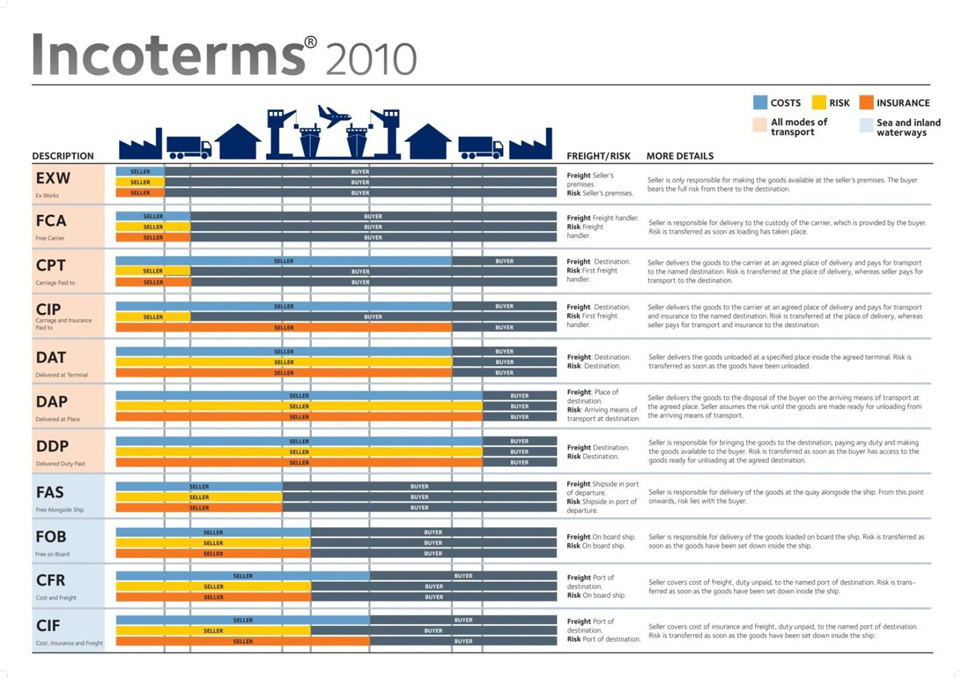General notes:
The following diagram provides an overview of the Incoterm definitions:
General notes:
The following diagram provides an overview of the Incoterm definitions:

igure 2: Incoterms 2010
| Group E – Departure | Group F – Main carriage NOT paid by seller | Group C – Main carriage paid by seller | Group D – Arrival |
|---|---|---|---|
| EXW – EX Works | FCA – Free Carrier FAS – Free Alongside Ship FOB – Free On Board | CFR – Cost and Freight CIF – Cost, Insurance and Freight CPT – Carriage Paid To CIP – Carriage and Insurance Paid To | DAP – Delivered At Place DAT – Delivered At Terminal DDP – Delivered Duty Paid |
E Group
Used where the seller does not want to arrange transport.
Means the seller’s only responsibility is to make the goods available at the seller’s premises. The seller is not responsible for loading the goods on the vehicle provided by the buyer unless otherwise agreed. The buyer bears the full costs and risk involved in bringing the goods from there to the desired destination. Ex works represents the minimum obligation of the seller.
Used where the seller can arrange some transport within his/her own country.
This term has been designed to meet the requirements of multi-modal transport, such as container or roll-on, roll-off traffic by trailers and ferries. The seller fulfils his/her obligations when the goods are delivered to the custody of the carrier at a named point. If no precise point can be named at the time of the contract of sale, the parties should refer to the place where the carrier should take the goods into its charge. The risk of loss or damage to the goods is transferred from seller to buyer at that time.
Requires the seller to deliver the goods along-side the ship on the quay. From that point on, the buyer bears all costs and risks of loss and damage to the goods. FAS requires the buyer to clear the goods for export and pay the cost of loading the goods.
The goods are placed on board the ship by the seller at a port of shipment named in the sales agreement. The risk of loss or damage to the goods is transferred to the buyer when the goods pass the ship’s rail (i.e. off the dock and placed on the ship). The seller pays the cost of loading the goods.
Used where the seller can arrange and pay for most of the freight charges up to the foreign country.
Requires the seller to pay the costs and freight necessary to bring the goods to the named destination, but the risk of loss or damage to the goods, as well as any cost increases, are transferred from the seller to the buyer when the goods pass the ship’s rail in the port of shipment. Insurance is the buyer’s responsibility.
This is CFR with the additional requirement that the seller procure transport insurance against the risk of loss or damage to goods. The seller must contract with the Insurer and pay the insurance premium. Insurance is generally important in international shipping because transport companies have restricted liability for loss or damage.
This term means the seller pays the freight for the carriage of the goods to the named destination. The risk of loss or damage to the goods and any cost increases transfers from the seller to the buyer when the goods have been delivered to the custody of the final carrier, and not at the ship’s rail. Accordingly, “freight/carriage paid to” can be used for all modes of transportation, including container or roll-on roll-off traffic by trailers and ferries. When the seller is required to furnish a bill of lading, way bill, or carrier receipt, the seller duly fulfils its obligation by presenting such a document issued by the person contracted with for carriage to the main destination.
This term (also abbreviated CIP) is the same as “freight/carriage paid to” but with the additional requirement that the seller has to procure transport insurance against the risk of loss or damage to the goods during the carriage. The seller contracts with the Insurer and pays the insurance premium.
Used where the seller can pay for most of the delivery charges to the destination country.
This term means that the seller’s obligations are fulfilled when the goods have arrived at the place but before the customs border of the country named in the sales Contract. The seller bears the full cost and risk in delivering the goods up to this point, but the buyer must arrange and pay for the goods to clear customs.
This term means that the seller has agreed to make the goods available to the buyer at the terminal at the destination named in the sales Contract. The seller bears the full cost and risks in delivering the goods to that point including unloading. There are two variations of ex-quay contracts: “ex-terminal duty paid” and “ex-terminal duty on buyer’s account.” In the first, the duty is paid by the seller. In the second, the duty also is paid by the seller, but the buyer must reimburse the seller.
Represents the seller’s maximum obligation. The term “DDP.” is generally followed by words indicating the buyer’s premises. It notes that the seller bears all risks and all costs until the goods are delivered. This term can be used irrespective of the mode of transport. If the parties wish to make clear that the seller is not responsible for certain costs, additional words should be added (for example, “delivered duty paid exclusive of VAT and/or taxes”).
